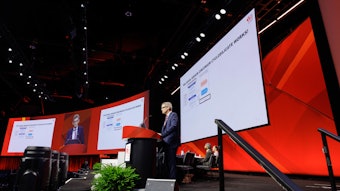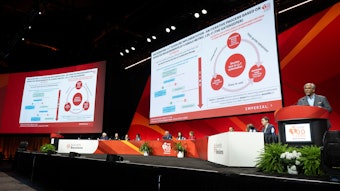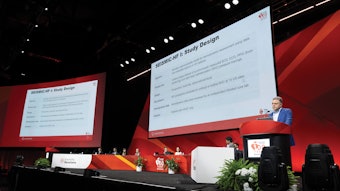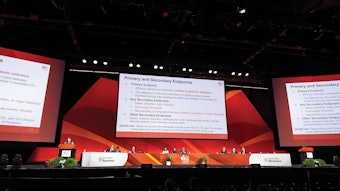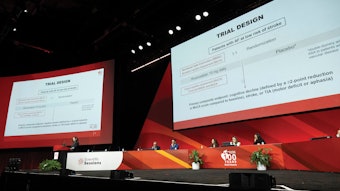LBS coverage (2020): AF trials reveal pragmatic screening and intervention opportunities
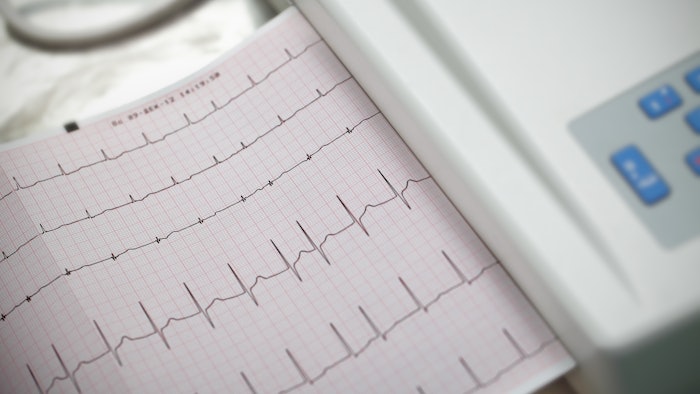
Investigators in four atrial fibrillation trials revealed compelling results during Monday’s “To Screen or Not to Screen, and Then What? Studies of Detection and Treatment of AF” Late-Breaking Science session.
They found:
- Continuous rhythm monitoring with an adhesive patch after cardiac surgery revealed a significant, persistent burden of asymtomatic but potentially actionable AF up to 30 days after the post discharge period.
- Single-lead ECG screening at primary care visits didn’t increase the likelihood of a new AF diagnoses for those >65 years of age, but did for those >85 years old.
- A wearable ECG patch identified asymptomatic AF early and improved clinical outcomes at three years.
- First-line cryoballoon ablation is associated with significant reductions in adverse arrhythmia outcomes.
Wearable monitor detects POAF after discharge
The SEARCH-AF CardioLink Trial provides significant proof that the risk for post-operative atrial fibrillation (POAF) persists after patients leave the hospital following cardiac surgery.
“Atrial fibrillation after heart surgery is a common clinical problem,” said Subodh Verma, MD, PhD, cardiac surgeon-scientist at St Michael’s Hospital in Toronto and the study’s principal investigator. “We followed patients with an adhesive cardiac rhythm monitoring device to see if we could identify patients at risk of AF after discharge who might benefit from therapeutic interventions.”
Enrollment for SEARCH-AF was March 10, 2017, to March 3, 2020, when it was suspended due to COVID-19. At that time, 336 patients were randomized from eight Canadian sites, achieving 85% of the planned sample size.
All participants underwent cardiac surgery and were at high risk for stroke with a mean CHA2DS2-VASc score of 4.0. Patients had no history of atrial fibrillation/atrial flutter (AF/AFL) prior to surgery and showed no signs of POAF or fewer than 24 hours of POAF in the hospital after surgery.
Those in the intervention group were continuously monitored for 30 days after discharge with an adhesive, patch-based cardiac rhythm monitor. The two brands used were Medtronic SEEQ™ mobile cardiac telemetry system and the Icentia CardioSTAT® cardiac rhythm monitoring device.
The control group received usual care with no cardiac rhythm testing for the first 30 days.
The primary endpoint of the study was to determine the proportion of participants with sustained AF/AFL of ≥6 minutes within 30 days after randomization, or documentation of AF/AFL by 12-lead ECG. The results demonstrated a very high rate of unrecognized AF.
In the study group, AF/AFL was detected in 32 (19.6%) patients versus just three (1.7%) in the usual care group (absolute risk difference 17.9%, 95% CI 11.5-24.3%, P<0.001).
“Our study suggests that nearly 20% of post-cardiac surgery patients without pre-operative or pre-discharge AF have an unrecognized risk of ongoing, and potentially actionable, AF after discharge,” Dr. Verma said. “The data underscores the importance of ongoing surveillance and vigilance in these patients.”
AF screening during primary care visits doesn’t increase diagnoses
Would physicians be open to conducting an atrial fibrillation screening during a routine primary care visit? Would more AF be diagnosed and treated?
Those questions inspired VITAL-AF — the largest, cluster-randomized trial of point-of-care screening for atrial fibrillation.
“Single-lead, handheld electrocardiogram devices make screening for undiagnosed AF during a primary care exam feasible and appealing — it takes just 30 seconds, with no disrobing or adhesive electrodes required,” said primary investigator Steven A. Lubitz, MD, MPH, a cardiologist and cardiac electrophysiologist at Massachusetts General Hospital in Boston. “If AF is identified, the physician can take action right away.”
VITAL-AF enrolled 35,308 patients 65 years and older. Clinical staff offered screening with AliveCor® KardiaMobile 1L-ECG to a half of the participants during vital sign assessments. Over one year, 91% of those in the intervention arm underwent screening. The other half continued with usual care.
After excluding people with prevalent AF, the sample size was reduced to 15,397 in the intervention arm and 15,325 in the control arm.
At 12 months, investigators reported that AF screening was easily implemented at the primary care clinics. However, screening didn’t lead to higher AF detection. For all patients 65 and older, there were 1.74% new diagnoses with the intervention and 1.60% with usual care.
The intervention became more effective as patients got older. Among a subset of patients 85 and older, new AF was detected in 5.64% of the study group versus 3.76% of the control group.
Limitations in the study included a non-diverse patient population at a single academic medical center. The investigators couldn’t rule out contamination due to increased attention to AF in the control practices.
The findings also suggested that AF screening as a vital sign at a primary care clinic seemed to shift the setting of a patient’s subsequent AF diagnosis to an outpatient or primary care office location, rather than a hospital or emergency department.
“Additional analysis of our data will help us understand whether new diagnosis of AF in the primary care setting is impactful with regard to treatment and outcomes,” Dr. Lubitz said.
Wearable monitor results in new AF diagnoses and improved outcomes
A wearable ECG patch identified asymptomatic AF early and improved clinical outcomes, according to the mHealth Screening To Prevent Strokes (mSToPS) Trial.
“This is the first-ever, prospective, pragmatic, direct-to-participant, nationwide trial to screen for AF before symptoms arise,” said lead author Steven Steinhubl, MD, cardiologist and clinical researcher at Scripps Research Translational Institute in La Jolla, California.
Investigators expected to find new AF cases with the wearable monitors. The surprise came at the end of the three-year study.
“We not only identified AF in asymptomatic patients, we significantly improved their clinical outcomes and safety at three years relative to routine care,” Dr. Steinhubl said.
The nationwide study enrolled and actively monitored 1,718 participants without AF via the Aetna® insurance company. The patients received two iRhythm Zio®XT devices by mail. Each self-applied patch monitored and recorded the wearer’s continuous ECG for up to two weeks. A matched control group of 3,371 participants received routine medical care with no wearable sensor.
Of the actively monitored participants, 11.4% were newly diagnosed with AF. They and their physicians were informed but received no specific treatment recommendations. Only 7.7% of the control group were diagnosed with AF during their routine office screenings.
Despite similar treatment, the patch patients fared better over time. Using a primary combined endpoint of death, stroke, myocardial infarction or systemic emboli, the actively monitored group experienced significantly fewer events than the those with clinically diagnosed AF.
“Many studies make for good reading, but the results don’t change day-to-day practice,” Dr. Steinhubl said. “The mSToPS trial supports that large-scale monitoring of patients at home for AF should begin today. Personal digital-health devices are creating a brand-new care pathway.”
First-line ablation outperforms first-line anti-arrhythmic drugs
The Early Invasive Intervention for Atrial Fibrillation (EARLY-AF) Trial demonstrated the superiority of ablation over anti-arrhythmic drugs (AAD) for AF recurrence, quality of life measurements and total AF burden.
“When AAD therapy is ineffective or cannot be tolerated, the next choice is often catheter ablation,” said Jason G. Andrade, MD, cardiac electrophysiologist and associate professor at the University of British Columbia in Vancouver. “Unfortunately, patient outcomes are worse when ablation is delayed. We wanted to see how first-line cryoablation would perform against first-line AAD.”
EARLY-AF was a multicenter, parallel-group, randomized trial that enrolled 303 participants with treatment-naïve, symptomatic AF. Patients were relatively young and healthy with an average age of 58. The study group of 154 patients underwent first-line ablation. The control group of 149 patients received first-line AAD.
Investigators took several steps to ensure a robust comparison between the two groups. Implantable loop recorders (ILR) continuously monitored the patients to determine the exact timing and extent of arrhythmia recurrence.
Standardized titration protocols for AAD were optimized in the control group using ILR data with the goal of complete AF suppression. In addition, an independent committee monitored the two treatment groups to minimize crossover.
All patients were evaluated during scheduled visits at three, six and 12 months. They were also interviewed about their health and quality of life.
At every stage of follow-up, first-line ablation was associated with significant benefits over first-line AAD therapy. At 12 months, 57.1% of the ablation group were free from any atrial tachyarrhythmia on ILR versus 32.2% of the AAD group. Ablation was similarly associated with less symptomatic recurrences and a lower AF burden. The ablation group also reported meaningful improvements in multiple quality of life measures, and they were more likely to be asymptomatic. Adverse events were similar between the two groups.
“After five years, we’re excited to share the results of this randomized head-to-head comparison between two first-line AF interventions,” Dr. Andrade said.



